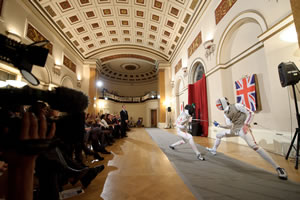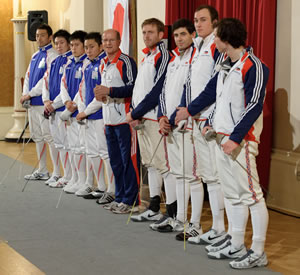
Image: David Court |
'The Lansdowne International Challenge' is an annual event in which a national fencing team is invited to take part in an exhibition match with the British Foil Team. This year it was the Club's pleasure to invite the current Japanese National Foil Team.
Some people say that fencing is not a spectator's sport, but as the fencing on the evening of Friday, 22 October demonstrated, this is clearly not the case. Over two hundred spectators squeezed in to the Ballroom at the Lansdowne Club to witness some of the best fencing in the world. The Japanese Team is currently ranked 4th in the world and benefits from the experience of Yuki Ota (silver medallist at the Beijing Olympics and ranked 6th in the world), Kenta Chida, Suguru Awaji and Kyoya Ichikawa as reserve.
|
They faced the best of the British fencers, who are also ranked among the top ten teams in the world. It was unfortunate that on that night Richard Kruse, current British Champion and ranked 4th in the world, was unable to fence due to a foot injury, but the fact remained that though the British team were missing their finest fencer, it did not dampen their fighting spirit.
The question that many of you may be asking is how do you score a team fencing match? The simple answer is that it is the first team to reach 45 hits. Those 45 hits are achieved through fencing nine fights, allowing each team member the chance to fight each other. The bouts are short - three minutes at most, and they can be quicker if one fencer gets the first five hits. Fast attacks and impressive blade work meant that the teams were neck and neck much of the way through the match, though the British team always trailed a few points behind the Japanese. The Japanese team successfully countered the British team's attacks with lightning-fast counter attacks. The agility of these sportsmen was astonishing to watch. They travelled up and down the piste testing and teasing their opponents, waiting for the perfect moment for their attacks. When it happened, it was an explosion of energy. After one of the closest fought fights, the final score was Japan 45 hits, Great Britain 41 hits.
|

Image: David Court |
The Japanese team is currently undergoing joint training with the British team at state-of-the art facilities at the University of Bath in preparation for the World Championships to be held in Paris on 5 November. The contrasting styles and sizes of the fencers from the two countries make joint training mutually beneficial as they prepare for competition on the international stage. Many more visits to the UK are expected to follow by the Japanese team as they prepare for the 2012 London Olympics.
The fact that the match was being held at the Lansdowne Club was of special interest being that it was here on January 30 1902, that the first Anglo-Japanese Alliance was signed between the British foreign secretary, Lord Landowne and the Japanese minister in London, Hayashi Tadasu. This treaty was signed in the Round Room - the same room where Lord Lansdowne's ancestor, the Earl of Shelburne, drafted the Treaty of Paris in 1783.
|
Rupert Davies-Cooke
Chairman, the Lansdowne Fencing Club |
|

